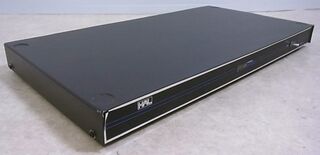Difference between revisions of "PCG-8100"
From NEC Retro
| Line 12: | Line 12: | ||
Stock PC-8001 units lack traditional graphics modes, meaning software is entirely composed from text characters. However only a finite number of characters exist in memory and cannot be changed; by introducing more which can, the computer can be used not only to display text characters not contained within in the default set, but create any 8x8 pixel pattern, thus opening the door for rudmentary graphics. This was particularly important for video games, to the point where many PC-8001 titles require a PCG-8100 to function correctly (some are even marked as "PCG-8100 games"). | Stock PC-8001 units lack traditional graphics modes, meaning software is entirely composed from text characters. However only a finite number of characters exist in memory and cannot be changed; by introducing more which can, the computer can be used not only to display text characters not contained within in the default set, but create any 8x8 pixel pattern, thus opening the door for rudmentary graphics. This was particularly important for video games, to the point where many PC-8001 titles require a PCG-8100 to function correctly (some are even marked as "PCG-8100 games"). | ||
| − | In addition, the PC-8100 adds either one (or three, depending on the model) sound channels, replacing the stock beeper. | + | In addition, the PC-8100 adds either one (or three, depending on the model) sound channels, replacing the stock beeper. While games optimised for the PCG-8100 require the device to look as intended, they will usually still function on stock hardware, just with the wrong graphics. Some games, like ''[[Head-On Part 2]]'', advertise as being compatible with both stock PC-8001 systems and the PCG-8100; the graphics aren't accurate without a PCG-8100, but the game is still playable. |
The PCG-8100 was not the only such device on the market, with HAL producing similar accessories for other text-based machines (the PCG-8000 and PCG-6500 for the MZ-80K (and MZ-80C) and Commodore PET, respectively). The [[PCG-8200]] and [[PCG-8800]] provide similar functionality for the [[PC-8001 mkII]] and [[PC-8801]] respectively, although these machines also have dedicated graphics modes. | The PCG-8100 was not the only such device on the market, with HAL producing similar accessories for other text-based machines (the PCG-8000 and PCG-6500 for the MZ-80K (and MZ-80C) and Commodore PET, respectively). The [[PCG-8200]] and [[PCG-8800]] provide similar functionality for the [[PC-8001 mkII]] and [[PC-8801]] respectively, although these machines also have dedicated graphics modes. | ||
Revision as of 11:09, 25 January 2022

| ||||||||||
| PCG-8100 | ||||||||||
|---|---|---|---|---|---|---|---|---|---|---|
| Made for: PC-8001 | ||||||||||
| Manufacturer: HAL Kenkyuujo | ||||||||||
|
This short article is in need of work. You can help NEC Retro by adding to it.
The PCG-8100 is an add-on device for the original PC-8001 computer created by HAL Kenkyuujo. It is a programmable character generator, which as the name might suggest, gives the computer a further 128 characters which can be programmed.
Stock PC-8001 units lack traditional graphics modes, meaning software is entirely composed from text characters. However only a finite number of characters exist in memory and cannot be changed; by introducing more which can, the computer can be used not only to display text characters not contained within in the default set, but create any 8x8 pixel pattern, thus opening the door for rudmentary graphics. This was particularly important for video games, to the point where many PC-8001 titles require a PCG-8100 to function correctly (some are even marked as "PCG-8100 games").
In addition, the PC-8100 adds either one (or three, depending on the model) sound channels, replacing the stock beeper. While games optimised for the PCG-8100 require the device to look as intended, they will usually still function on stock hardware, just with the wrong graphics. Some games, like Head-On Part 2, advertise as being compatible with both stock PC-8001 systems and the PCG-8100; the graphics aren't accurate without a PCG-8100, but the game is still playable.
The PCG-8100 was not the only such device on the market, with HAL producing similar accessories for other text-based machines (the PCG-8000 and PCG-6500 for the MZ-80K (and MZ-80C) and Commodore PET, respectively). The PCG-8200 and PCG-8800 provide similar functionality for the PC-8001 mkII and PC-8801 respectively, although these machines also have dedicated graphics modes.
Compatible games
- Flight Bomber
- Flying Fox
- Head-On Part 2
- Ice Dreaming
- Jupiter Lander
- Night Drive
- PCG Asteroid Belt
- PCG Car Race
- PCG Circuit
- PCG Golgo 15
- The PCG Guardian
- PCG Lunar City SOS!!
- PCG New Southern Cross Rally
- PCG Porter
- PCG Puckn Boy
- PCG. Armer Balloon
- PCG. Cosmic Ineiger
- PCG. Cosmo Traveler
- PCG. Melyos
- Rader Scope
- Rally X
- Space Phoenix
- Space War
- Spider Rescue
- The Star World II
- Super Mahjong
Physical scans
| PC-8001, JP |
|---|
|
References
| PC-8000 series hardware |
|---|
| PC-8001 (1979) | PC-8001 mkII (1983) | PC-8001 mkII SR (1985) |
| stuff |
| put something here |